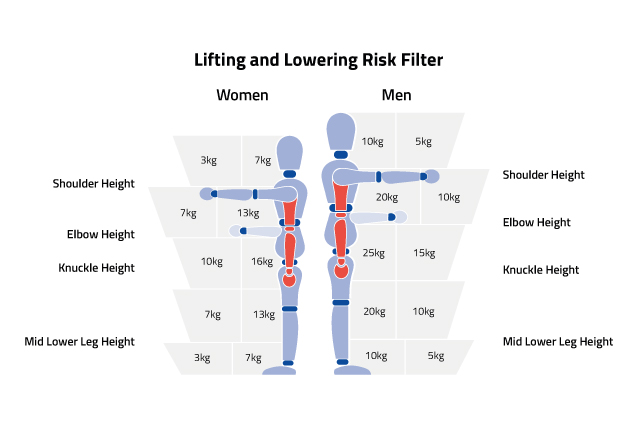
Every workplace is different, and every career has different responsibilities; some people might be expected to do a large amount of manual handling and lifting daily, while some people might go for years lifting nothing more than a pen.
What Is Manual Handling?
According to government legislation, manual handling is defined as: “the transporting or supporting of a load (including lifting, putting down, pushing, pulling, carrying or moving) by hand or by bodily force.” Basically, it's the handling of any load whether you're lifting it, dragging it, pushing it, 'manual handling' covers the whole lot.
One in three accidents at work are caused by manual handling, with many of these injuries affecting the back. In fact, every year 300,000 people in the UK suffer from back pain due to manual handling accidents.
With so many accidents occurring every day in the workplace, how can we know how much is safe to lift, and what can we do to keep ourselves safe when lifting?
Is There a Legal Limit to Manual Lifting?
How Much Can I Safely Lift?
Legally, there is no assigned maximum weight you can lift. However, there are lots of things you should take into consideration when getting ready to lift something heavy:
- Your personal lifting capabilities
- How long will you be carrying the load?
- Will you be transporting it over uneven surfaces, e.g. stairs?
- Do you have the suitable training to be lifting such a load?
Since there is no legal limit and no figure that can be applied to everyone, when it comes to determining how much is safe to lift, you have to use your initiative.
Consider how much you can reasonably carry, where you’ll be carrying, how long you’ll be carrying, and use reasonable judgement. And remember: it’s always better to wait for someone to be available to help you, rather than rushing ahead by yourself and risking an accident.
How To Avoid Injury When Manual Handling
There are a number of steps you can take to reduce the risk of injury when carrying out manual handling operations:
Assess Loads Before Handling
As established above, there is no legal limit to how much you can lift. However, to reduce the risk of accident or injury when manual handling, carrying out a quick inspection of the load to determine the risk level can help keep yourself and others safe.
Whilst it is impossible to definitively determine whether a load is categorically “safe” or “unsafe”, it is possible to identify whether a load is high-risk or low-risk. Heavy, cumbersome loads might be considered high risk, where as easy-to-manage loads are low-risk.
If you’re looking for guidance on how to determine whether a load is high-risk or low-risk, the figure below may be useful to you.

This diagram is a suggestion of loads that could be considered low risk when handled correctly. For example, when the load is grasped firmly with both hands and is being held with appropriate positioning and posture.
If you’d like more detailed advice on manual handling at work and load assessment, the Health and Safety Executive (HSE) has a useful Manual Handling at Work Guide that offers some more in-depth advice on steps you can take to reduce the risks of injury when material handling.
Carry out Risk Assessments
Another way you can prevent accident or injury during manual handling operations is to ensure that you have conducted a thorough risk assessment beforehand. Identifying potential risks before they occur is a great way to reduce the chances of an accident occurring and ensure that you’re fully prepared for any complications should they occur.
Risk assessments vary from workplace to workplace. The Health and Safety Executive offer some excellent risk assessment resources that breakdown the various steps and requirements of a risk assessment that help to make manual handling risk assessments simple.
Additional Steps to Reduce Risk of Injury:
- Avoid stooping, bending, ducking, stooping, and over-reaching whenever possible.
- Avoid lifting from floor level or about shoulder height.
- Try to avoid lifting alone or unsupervised
- Lift smart: can the load be broken into smaller loads? Is there a way you could transport it other than manual handling?
If you'd like to learn more about manual handling, take a look at our manual handling training course. If you have any further questions about workplace safety, feel free to contact us and we'll do everything we can to help.

